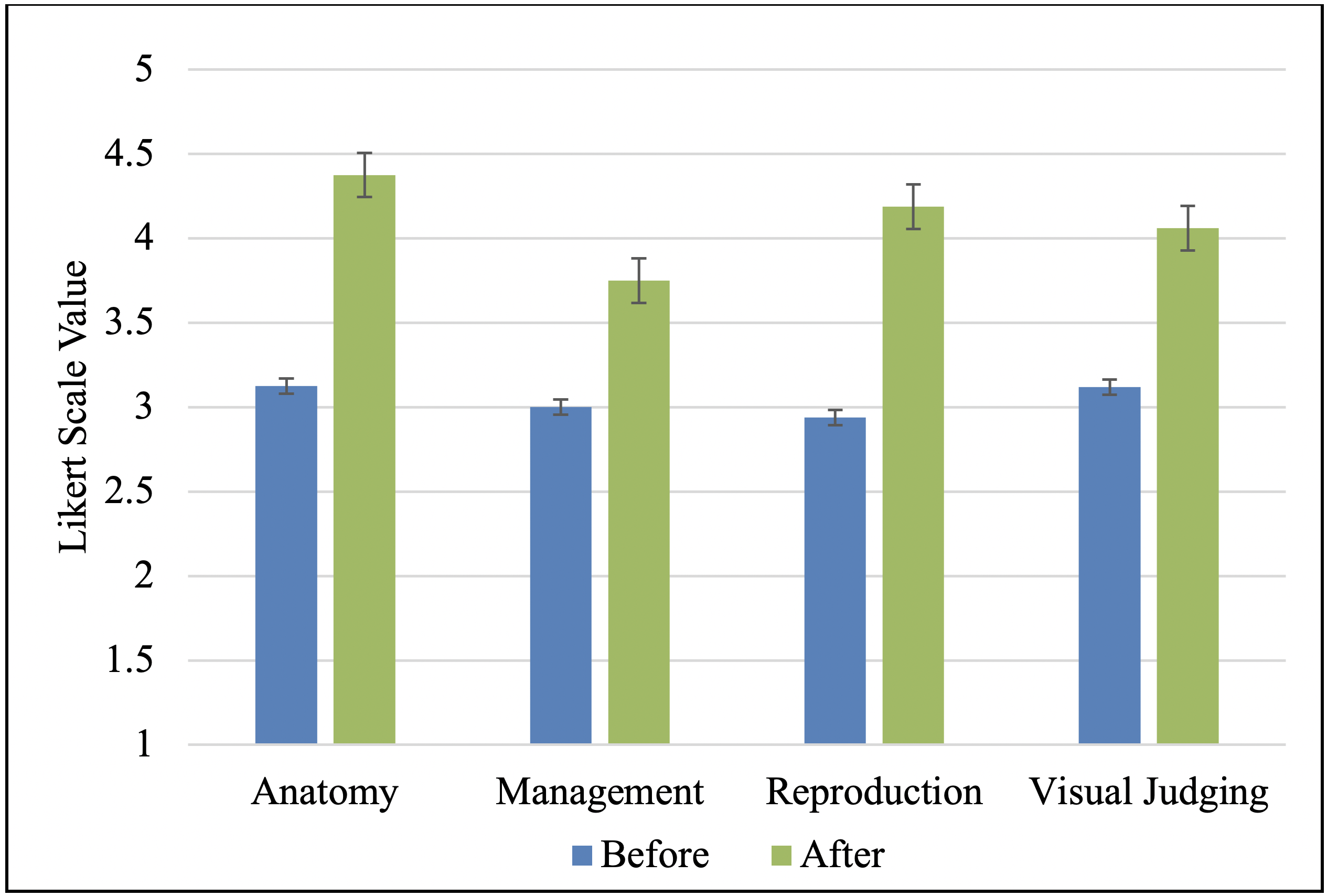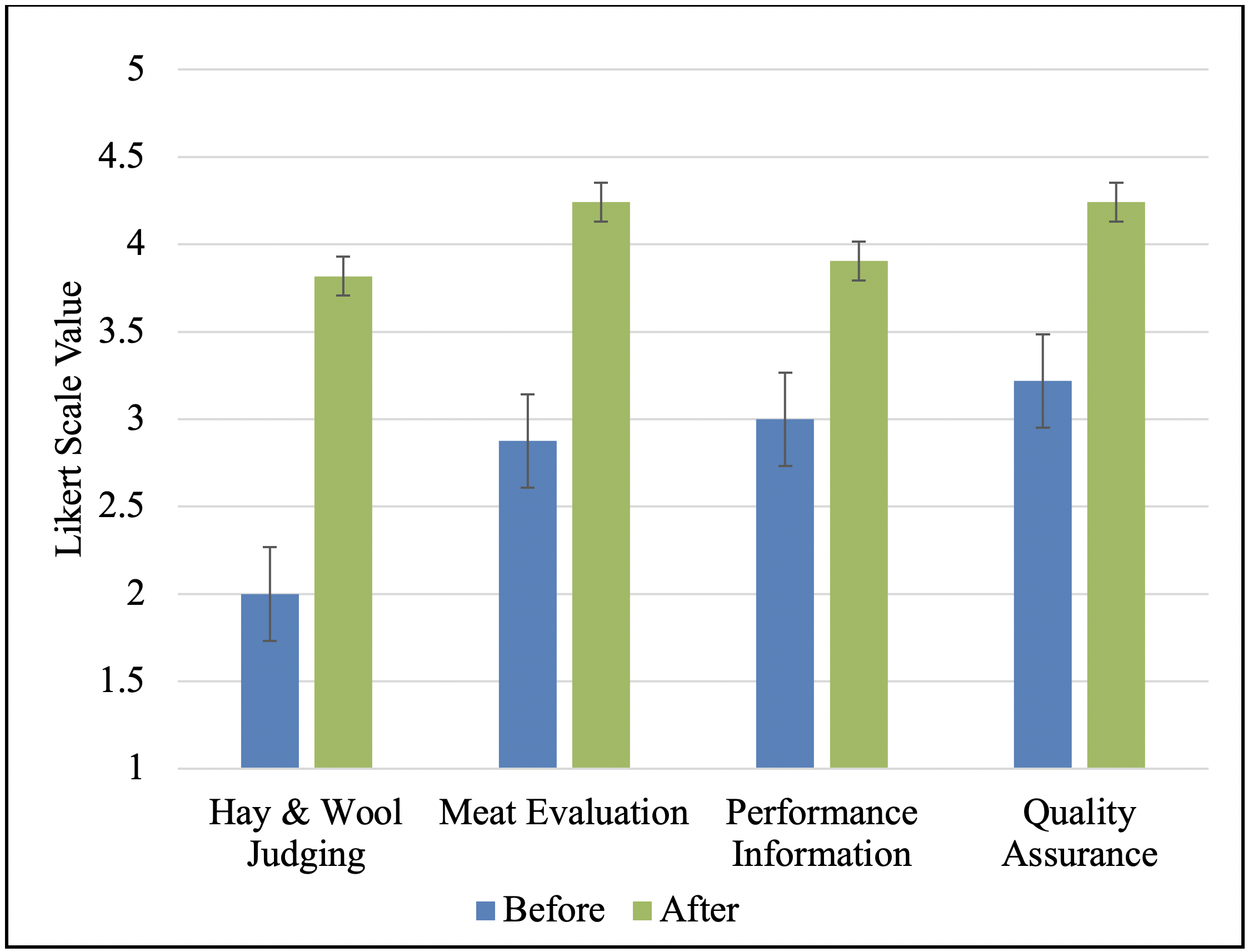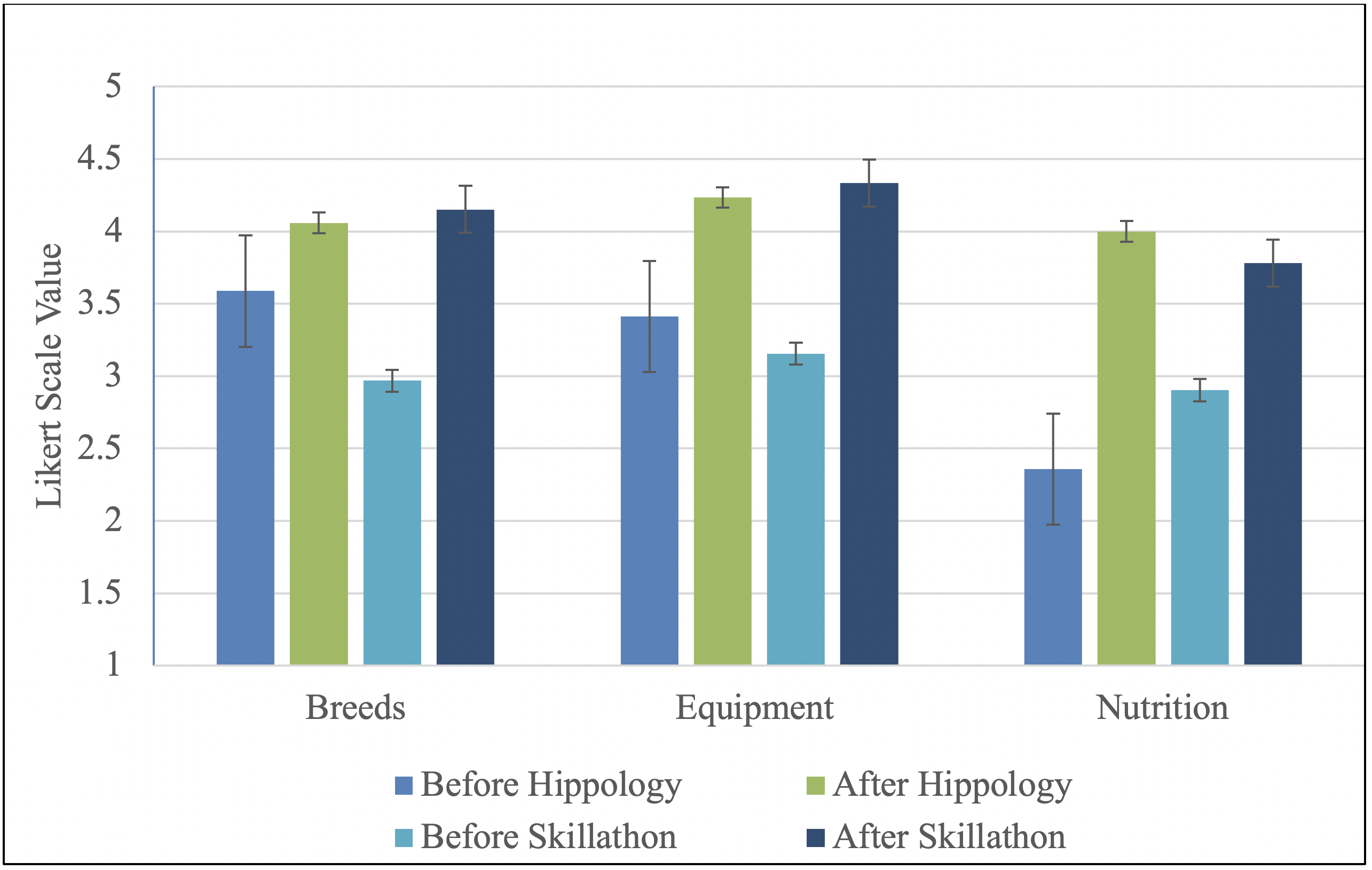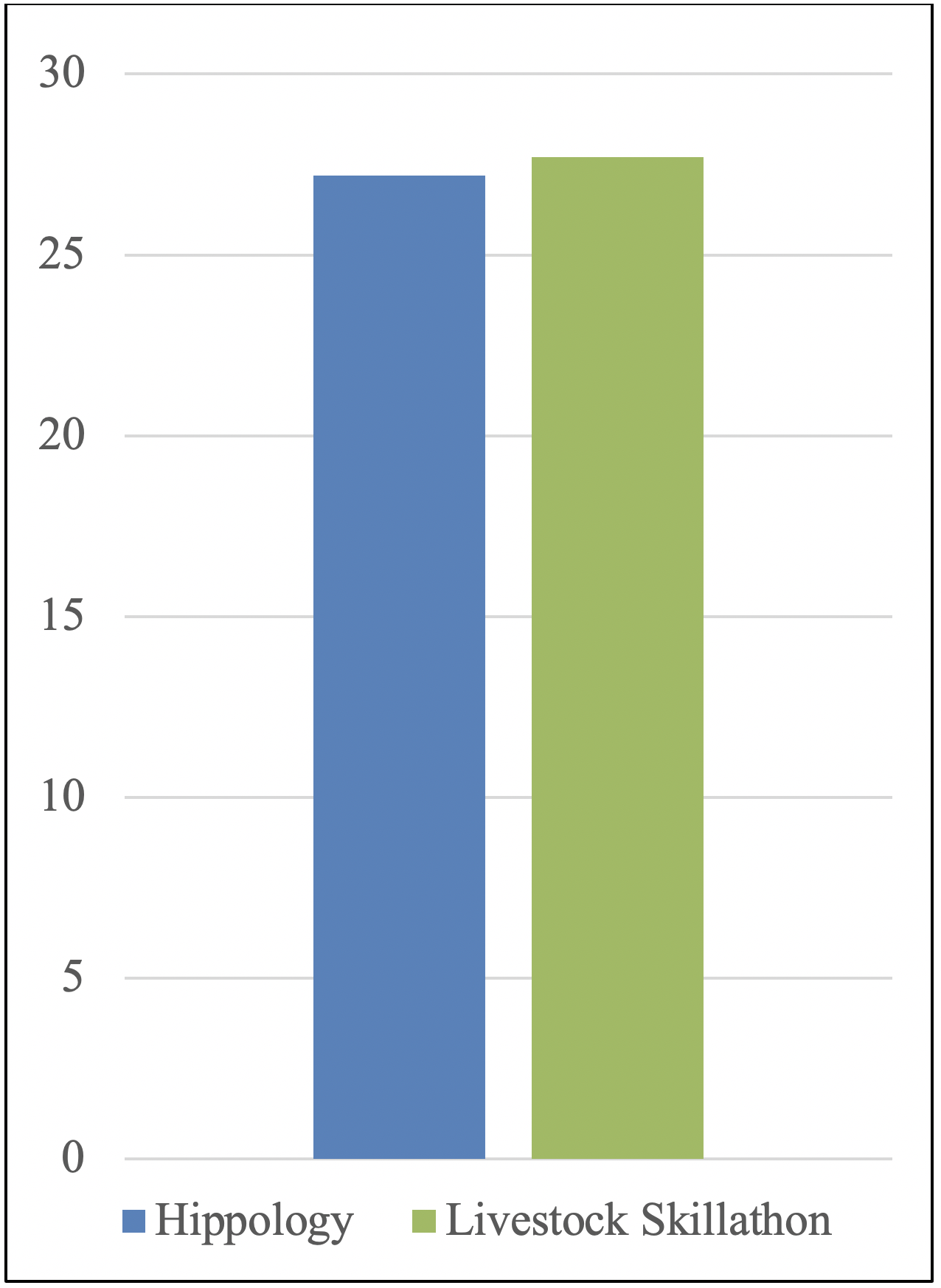 |
October 2020
|
October 2020 // Volume 58 // Number 5 // Research In Brief // v58-5rb3
National 4-H Hippology and Livestock Skillathon Contests Affect Knowledge and Skills
Abstract
Using a mixed model, we evaluated effects of national 4-H hippology and livestock skillathon contests on youths' content knowledge, 21st century skills, and postsecondary plans. Hippology participants gained significant knowledge in all topics except breeds, and livestock skillathon contestants gained significant knowledge in all topics. The contests were similar in their effects on development of 21st century skills and postsecondary plans. Gains in content knowledge indicate that contest preparation is an effective method for increasing youths' technical knowledge. Additionally, findings suggest that contest preparation is a viable venue for 21st century skill development and that such skill development is not specific to topic.
Introduction
To determine how involvement in national 4-H hippology and livestock skillathon programming affects youths, we evaluated the events to determine their effects on participants' content knowledge, 21st century skill development, and postsecondary plans. Prior research regarding 4-H livestock projects and 21st century skills has been reported; however, there is limited information on hippology and skillathon events.
A 4-H hippology contest allows 4-H members to demonstrate their knowledge related to equine science and horse husbandry. The contest includes the individual components of examination, stations, and judging, along with a team problem-solving component. Topic areas addressed at the contest are anatomy, breeds, equipment, management, nutrition, reproduction, and visual judging/selection.
In livestock skillathons, youths learn about livestock management. Classes completed individually focus on breeds, equipment, hay judging, wool judging, livestock knowledge, meat cut identification, and quality assurance. Topics of team components include animal breeding, meat and carcass evaluation, nutrition, performance and marketing, and quality assurance.
Comparable to life skills discussed in 4-H literature, 21st century skills are a wide set of skills, knowledge, and habits that are crucial to success in today's academics and workplace. Cross-disciplinary, transferable soft skills needed by students for success include information, media, and technology skills; learning and innovation skills; and life and career skills (Partnership for 21st Century Learning, 2016).
Literature Review
Judging, skillathons, livestock projects, and 4-H involvement contribute to development of 21st century, or life, skills. In one study, 63% to 65% of participants in 4-H horse judging and livestock contests stated that the contests contributed to their success, helped prepare them for the workforce, and improved their livestock knowledge (Nash & Sant, 2005). Furthermore, 27% reported being better at quick thinking because of their involvement (Nash & Sant, 2005). Results from the Youth Leadership Life Skills Development Scale administered to youths who participated in the Tennessee 4-H Sheep Skillathon showed that youths had the largest gains in respecting others, solving problems, setting goals, and having good manners (Kimes et al., 2016). Overall, participants felt they made moderate gains in life skills due to their involvement in the 4-H Sheep Skillathon (Kimes et al., 2016). In Indiana, 44% of 4-H livestock project members surveyed reported that they applied the responsibility learned in 4-H livestock projects to complete their schoolwork and noted the importance of dedication learned from livestock projects (Rusk et al., 2003). Also, 4-H members gained transferable knowledge, developed self-confidence, improved their people skills, and improved decision-making skills (Rusk et al., 2003). For Nebraska 4-H alumni, 4-H was a primary influencer in development of responsibility, ability to meet new people, leadership, project skills, presentation skills, self-confidence, and willingness to try new things (Fox et al., 2003). The variety of activities in hippology and livestock skillathon programming provides youths with opportunities to benefit similarly.
Methods
Following approval of our project by the South Dakota State University Institutional Review Board, we attended the 2017 National 4-H Livestock Skillathon (LS) and then 2018 Western National 4-H Roundup Hippology (HP) contests to inform team coaches of our study, gather email addresses of participants or parents, and conduct focus group research. We asked all participants (HP = 52, LS = 73) to voluntarily provide email addresses for online survey participation and invited participants over 18 (HP = 8, LS = 18) to join the respective focus group.
Data Collection
We collected quantitative data from 33% of HP participants (n = 17) and 45% of LS participants (n = 33). These participants completed a survey comprising Likert scale and binary (yes-no) questions. Specifically, we used a retrospective "post-then-pre" design involving Likert scale response options of 1 (no knowledge) to 5 (significant knowledge) to determine participants' content knowledge gain in anatomy, breeds, equipment, management, nutrition, reproduction, visual judging/selection, hay and wool judging, meats, performance and marketing, and quality assurance. We used an item with Likert scale response options of 1 (no gain) to 5 (significant gain) to elicit participants' self-assessment of their gains in the 21st century skills of ability to understand complex information, ability to work in a team, creativity, leadership, public speaking abilities, responsibility, and work ethic. Three binary questions addressed influence of the contests on participants' postsecondary education plans, career or study plans, and plans for further education in a related field. See Appendix A for the survey.
We asked members of two focus groups (HP n = 2, LS n = 5) 12 questions that were sequenced as opening, introductory, transition, key, and ending questions to allow maximum insights (Krueger & Casey, 2000). Participants first became familiar with the topic while they thought and spoke of their experiences and listened to others. Next, we asked participants core questions related to 21st century skills and knowledge gained. Finally, participants were asked to summarize their thoughts on the contest. We recorded responses on video and via a scribe. See Appendix B for the focus group questions.
Data Analysis
We analyzed responses to the retrospective post-then-pre question using a signed-ranks test and adjusted p values for multiple related question parts. To compare knowledge gains in common content areas between contests, we used a Wilcoxon rank-sum test. Significance level was set at p < .05 for all tests. We analyzed Likert scale responses to the item on 21st century skill development using the Wilcoxon rank-sum test for nonparametric data. Pooled t tests were used for composite scores in each contest. For the binary questions, we completed chi-square tests for equality of proportions.
For the qualitative data, we used transcript-based analysis (Krueger & Casey, 2000). We transcribed recordings, added scribe notes, and deidentified participants. We used axial coding to analyze the data. We developed a key to code for the 21st century skills, including ability to understand complex information, ability to work in a team, creativity, leadership, public speaking abilities, responsibility, and work ethic.
Results
Quantitative
Participants in HP made significant gains in knowledge for all topics specific to HP, which were anatomy, management, reproduction, and visual judging (Figure 1). Participants in LS made significant knowledge gains in all topics specific to LS, which were hay and wool judging, meat evaluation, performance information, and quality assurance (Figure 2). The topics of breeds, equipment, and nutrition were common to both contests. The HP participants gained (p < .05) knowledge in equipment and nutrition, and LS participants gained (p < .05) knowledge in breeds, equipment, and nutrition (Figure 3).
Figure 1.
Content Knowledge Before and After Contest—Hippology

Figure 2.
Content Knowledge Before and After Contest—Livestock Skillathon

Figure 3.
Content Knowledge Gain in Shared Content Topics

Youths' perceptions of 21st century skill development did not differ (p = .78) between contests when skills were grouped as a composite (Figure 4) or evaluated individually (Table 1). The most gains were made in ability to understand complex information, ability to work in a team, responsibility, and work ethic (Table 1).
Figure 4.
Mean Composite Scores of 21st Century Skills

| Skill | Hippology | Skillathon | p value* |
|---|---|---|---|
| Ability to understand complex information | 4.00 | 4.03 | .96 |
| Ability to work in a team | 4.11 | 4.15 | .90 |
| Creativity | 3.47 | 3.58 | .92 |
| Leadership | 3.71 | 3.88 | .56 |
| Public speaking abilities | 3.88 | 3.88 | .89 |
| Responsibility | 4.06 | 4.15 | .77 |
| Work ethic | 4.06 | 4.06 | .91 |
|
Note. Values based on responses to Likert scale of 1 (no gain) to 5 (significant gain). *Probability > |Z| for Wilcoxon two-sample test. |
|||
There was no difference (p = .12) between contests in regard to influence on participants' future plans or career plans (Table 2). There was a tendency (p = .09) for LS participation to have a greater influence on education plans (Table 2).
| Variable | Hippology | Skillathon | p value* |
|---|---|---|---|
| Influenced future plans | 47% | 70% | .12 |
| Influenced career plans | 18% | 39% | .12 |
| Influenced education plans | 59% | 81% | .09 |
| *Probability of chi-square test. | |||
Qualitative
Our qualitative findings support the quantitative results regarding gains in knowledge about equine and livestock industries. Beyond the value of added knowledge, an LS participant stated that contest involvement "is way more important than just doing well for this contest. It's about learning the knowledge you need to be a successful producer." During the focus group discussion, an HP participant said, "On their nutrition . . . I learned a lot about that. A lot of that will probably make me a better horse owner." Such a comment confirms that HP participants believed they made gains in knowledge of equine nutrition.
When we asked focus group members how contest involvement had helped them develop 21st century skills, an HP participant gave this explanation:
The team problems helped me be more confident in my horse knowledge. And also . . . thinking on your feet and being quick to think because in the 21st century you have to be able to solve problems relatively quickly.
And an LS participant said this:
I'll definitely use my one that I talked about [delegation] . . . when I go back to college because, like, I know I have a group project coming up in one of my classes. You can't just . . . do it all. [The work has] to be split up and [you have to] trust people and let them do their best.
Results showed that participants felt they developed 21st century skills because of their involvement in these contests. This was affirmed when an HP participant said "It's definitely worth all the studying because it helps implement so many skills that you're going to need later in life."
Additionally, the tendency observed for LS participants' involvement to influence their decision to continue education was supported by focus group participants' responses. The most detailed comment from an LS participant was this:
I . . . liked studying science about livestock and animals in general . . . it will definitely impact my future in that I will continue down a path in livestock, whether that [will be] further[ing] my education to a master's or . . . [going to] vet school [to] continue fueling that passion for knowledge in this area.
Limitations
A limitation of our study is that we exclusively surveyed youths who participated in contests at a national level. We surveyed the national contest participants so that the results would be applicable regardless of geographic location. However, by using this procedure, we did not address youths who do not participate at the national level of competition, leading to sampling bias regarding competition level.
Conclusion and Implications
Participation in HP and LS resulted in knowledge increases in all content categories except breeds in HP. A knowledge gain for breeds in LS but not HP may be due to the difference in number of species included in each contest, as HP addresses only one species whereas LS addresses four species. Influences on 21st century skill development and youths' career plans following high school were similar across the contests. Ability to understand complex information, ability to work in a team, leadership, public speaking, responsibility, and work ethic were the skills for which participants perceived the most development, regardless of contest. The qualitative data provide insight into specific ways participants will use the knowledge gained and how they perceived that the contests supported 21st century skill development. Focus group participants valued the contests for developing academic and career preparatory skills.
The national scope of our research indicates that development of content knowledge and 21st century skills through these 4-H events applies regardless of original location of youths. Participants' perceptions of 21st century skill development were similar across the contests and thus were not specific to the technical content, confirming previous findings that many different 4-H experiences have positive influences on life skills development (Fox et al., 2003; Kimes et al., 2016). On the basis of our findings, we hypothesize that contests focused on other technical content also could contribute to development of 21st century skills.
Gains in content knowledge indicate that contest preparation is an effective method for increasing technical knowledge within specific subjects. The percentages of youths who reported that the contests influenced their future or educational plans (47%–81%) suggest that these events are viable ways for youths to explore postsecondary educational areas of interest.
Livestock producers and caretakers are closely scrutinized by the public in regard to appropriate animal care and management. The public desires assurance that livestock producers and animal owners are providing appropriate care and management of animals. Youths who have increased their content knowledge and 21st century skills through involvement in these events will have the skills and abilities to provide accurate information to the public regarding livestock care. Furthermore, for those who choose to enter a related career, increased knowledge will provide a strong foundation from which to start postsecondary education and their careers.
The learning and skill development evident from participation at the national level occurred due to practice and participation at local, regional, and state levels. Additional opportunities for youths to participate in similar experiences, potentially with different content but similar format, should be explored in an effort to appeal to youths with different interests. Extension personnel and volunteer coaches working with youths should emphasize the career preparation and gain in 21st century skill development youths perceived from participation in this type of event.
Author Note
Correspondence concerning this article should be addressed to Rosemarie Nold. Email: Rosemarie.nold@sdstate.edu
References
Fox, J., Schroeder, D., & Lodl, K. (2003). Life skill development through 4-H clubs: The perspective of 4-H alumni. Journal of Extension, 41(6), Article 6RIB2. https://joe.org/joe/2003december/rb2.php
Kimes, D. T., Stripling, C. T., Stephens, C. A., & Loveday, H. D. (2016). Understanding life skills gained from and reasons for youth participation in the Tennessee 4-H sheep skillathon. Journal of Extension, 54(4), Article v54-4rb7. https://www.joe.org/joe/2016august/rb7.php
Krueger, R. A., & Casey, M. A. (2000). Focus groups: A practical guide for applied research (3rd ed.) SAGE Publications.
Nash, S. A., & Sant, L. L. (2005). Lifeskill development found in 4-H animal judging. Journal of Extension, 43(2), Article 2RIB5. https://www.joe.org/joe/2005april/rb5.php
Partnership for 21st Century Learning. (2016). Framework for 21st century learning. https://www.battelleforkids.org/networks/p21/frameworks-resources
Rusk, C. P., Summerlot-Early, J. M., Machtmes, K. L., Talbert, B. A., & Balschweid, M. A. (2003). The impact of raising and exhibiting selected 4-H livestock projects on the development of life and project skills. Journal of Agriculture Education, 44(3), 1–11.
doi:10.5032/jae.2003.03001
Appendix A
Online Survey
-
Has your involvement in this National 4-H Contest influenced what you plan to do following high school?
- Yes
- No
-
Has your involvement in this National 4-H Contest changed your career or study plan following high school?
- Yes
- No
-
Has your involvement in this National 4-H Contest encouraged you to continue your education in an area that relates to this contest following high school?
- Yes
- No
-
Rank the following 21st century skills on how much you have gained because of your involvement with this National 4-H Contest. 1-5 with 1 being no gain, 3 being moderate gain, and 5 being significant gain.
-
Ability to work with a team12345
-
Public speaking abilities12345
-
Creativity12345
-
Leadership12345
-
Work ethic12345
-
Responsibility12345
-
Ability to understand complex information12345
-
-
Rank the following on your knowledge of the content. The scale is 1-5, with 1 being no knowledge, 3 being moderate knowledge, and 5 being significant knowledge. If the category is not covered in your contest, please select N/A.
-
Nutrition12345N/A
-
Evaluation of Performance Info12345N/A
-
Meat Judging12345N/A
-
Visual Judging12345N/A
-
Equipment ID12345N/A
-
Reproduction12345N/A
-
Breed ID12345N/A
-
Quality Assurance12345N/A
-
Farm Management12345N/A
-
Hay and Wool Judging12345N/A
-
Anatomy12345N/A
-
-
Rank the following on your knowledge of the content BEFORE you began preparing for this type of 4-H Contest. The scale is 1-5, with 1 being no knowledge, 3 being moderate knowledge, and 5 being significant knowledge. If the category is not covered in your contest, please select N/A.
-
Nutrition12345N/A
-
Evaluation of Performance Info12345N/A
-
Meat Judging12345N/A
-
Visual Judging12345N/A
-
Equipment ID12345N/A
-
Reproduction12345N/A
-
Breed ID12345N/A
-
Quality Assurance12345N/A
-
Farm Management12345N/A
-
Hay and Wool Judging12345N/A
-
Anatomy12345N/A
-
Appendix B
Questions Asked to Focus Groups
- 21st century skills have been described skills that are needed to be successful in careers and today's world. They could be emotions, abilities, skills, knowledge, et cetera. Can you think of any 21st century skills that you have developed because of your involvement in this 4-H contest?
- What aspects of the contest helped develop these skills? Examples could include an influential person, the written exam, the evaluation aspects, the team problems, etc.
- Can you tell me how you plan to use the 21st century skills that you have developed because of your involvement in this contest?
- How will these help you in the future?
-
What was the most difficult when you started and how did you improve?
- What did you learn from that experience?
- Did you experience different feelings when the team was successful versus not successful?
- Describe how those feelings affected your thoughts about the contest?
-
What made the team successful?
- How did you define success for your team?
-
How has your involvement in this National 4-H Contest influenced what you plan to do following high school?
- How has your involvement changed your career or study plan?
- How has your involvement encouraged you to continue your education?
-
In what areas do you feel that you have gained the most knowledge?
- Describe what made you successful in gaining that knowledge?
- If someone was considering joining a team for this contest but was not sure if it would be worth all the work that needs to be put in, what would you tell them?
- Is there anything else you would like to add?




